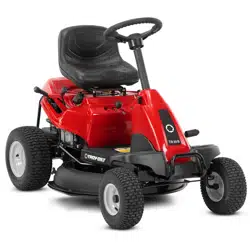Loading ...
Loading ...
Loading ...

18
OPERATION
1. Move the throttle/choke control (if equipped) or throttle
control (if equipped) into the FAST position.
2. Place the shift lever in either the FORWARD or REVERSE
position on 6-speed riding mowers. On hydro riding mowers,
slowly engage the forward drive pedal to travel FORWARD
until the desired speed is reached. To travel in REVERSE,
slowly engage the reverse drive pedal until the desired speed
is reached.
3. Depress the clutch-brake pedal and move the speed control
lever out of the parking brake position and into the desired
speed setting on 6-speed riding mowers. On hydro riding
mowers depress the brake pedal and move the parking brake
lever out of the parking brake position.
4. Release clutch-brake pedal slowly to put the riding mower in
motion on 6-speed riding mowers. On hydro riding mowers
slowly depress the forward or reverse drive pedal until the
desired speed is reached.
5. The riding mower is brought to a stop by depressing the
clutch-brake pedal or brake pedal.
IMPORTANT! Do NOT use the shift lever (if equipped) to change
the direction of travel when the riding mower is in motion.
Always use the clutch-brake pedal (if equipped) to bring the
riding mower to a complete stop before shifting.
IMPORTANT! First-time operators should use speed positions 1
or 2 on the shift lever (if equipped). Become completely familiar
with the riding mower’s operation and controls before operating
the riding mower at higher speeds.
NOTE: When operating the riding mower initially, there will be
little difference between the highest two speeds on the shift
lever (if equipped) until after the belts have seated themselves
into the pulleys during the break-in period.
WARNING
Before leaving the operator’s position for any reason,
disengage the blade, place the shift lever (if equipped) in
neutral, engage the parking brake, shut engine off, and
remove the key.
IMPORTANT! When stopping the riding mower for any reason
while on a grass surface, always:
1. Place the shift lever into neutral.
2. Engage the parking brake.
3. Shut the engine OFF and remove the key. Doing so will
minimize the possibility of having your lawn ‘‘browned’’ by
hot exhaust from your riding mower’s running engine.
If 6-speed riding mower stalls with speed control lever (if
equipped) in high speed, or if riding mower will not operate with
speed control lever (if equipped) in a low speed position, proceed
as follows:
1. Place shift lever (if equipped) in NEUTRAL.
2. Restart engine.
3. Place speed control lever (if equipped) in highest
speed position.
4. Release clutch-brake pedal (if equipped) fully.
5. Depress clutch-brake pedal (if equipped).
6. Place speed control lever (if equipped) in desired position.
7. Place shift lever (if equipped) in either FORWARD or REVERSE,
and follow normal operating procedures.
REVERSE CAUTION MODE IF EQUIPPED
The REVERSE CAUTION MODE
position of the ignition
module allows the riding mower to be operated in reverse with
the blades (PTO) engaged.
NOTE: Mowing in reverse is not recommended.
WARNING
Use extreme caution while operating the riding mower
in the REVERSE CAUTION MODE
. Always look down
and behind before and while backing. Do NOT operate the
riding mower when children or others are around. Stop
the riding mower immediately if someone enters the area.
To use the REVERSE CAUTION MODE
:
NOTE: The operator MUST be seated in the riding mower seat.
1. Start the engine as previously instructed.
2. Turn the key from the NORMAL MOWING (a) position
to the REVERSE CAUTION MODE
(b) position of the
ignition module. See Figure 20.
(d)
(e)
(c)
(a)
(b)
Figure 20
3. Press the REVERSE PUSH BUTTON (c) at the top, right
corner of the ignition module. The red indicator light (d) at
the top, left corner of the ignition module will be ON while
activated. See Figure 20.
4. Once activated (indicator light ON), the riding mower can be
driven in reverse with the cutting blades (PTO) engaged.
Loading ...
Loading ...
Loading ...
